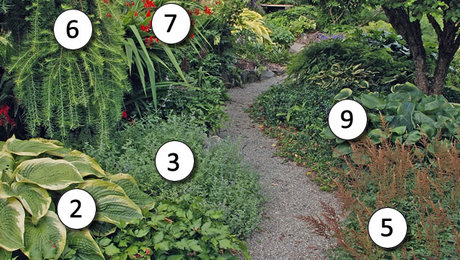“The best gardens are a beautiful blend of color, form, and texture.” This could be the opening line from almost any book on garden design. But what is texture? This question has haunted me since my first days of gardening. It seems like every garden designer I ask has a hard time defining it, as well. Most of us know what it is in theory—but explaining it, and infusing the right amount of it in a landscape, is when things get tricky.
Get more great planting plans in the pages of Fine Gardening magazine. If you’re not yet a subscriber, click here to get started!

- Mexican feather grass (Nassella tenuissima, Z 6-10)
- Lantana (Lantana camara, Z 9-11)
- Catmint (Nepeta x faassenii cv., Z 4-9)
- Mexican bush sage (Salvia leucantha, Z 9-11)
- Purple fountain grass (Pennisetum setaceum ‘Rubrum’, Z 9-11)
- ‘Yellow Wave’ New Zealand flax (Phormium ‘Yellow Wave’, Z 8-11)
- Oriental fountain grass (Pennisetum orientale, Z 5-10)

- Giant red aeonium (Aeonium ‘Cyclops’, Z 9-11)
- White valerian (Centranthus ruber ‘Albus’, Z 5-9)
- New Zealand flax (Phormium ‘Dazzler’, Z 8-11)
- Chinese fringe flower (Loropetalum chinense cv., Z 7-9)
- Festival™ cordyline (Cordyline x ‘JURred’, Z 8-11)

- Giant yucca (Yucca elephantipes, Z 9-10)
- Mexican feather grass (Nassella tenuissima, Z 6-10)
- Black rose (Aeonium arboreum ‘Zwartkop’, Z 9-11)
- ‘Rainbow Warrior’ New Zealand flax (Phormium ‘Rainbow Warrior’, Z 8-11)
- Bougainvillea (Bougainvillea cv., Zones 9-11)
- Jerusalem sage (Phlomis russeliana, Z 5-9)
- ‘Cherokee Chief’ dogwood (Cornus florida ‘Cherokee Chief’, Z 5-9)
- Chinese fringe flower (Loropetalum chinense cv., Z 7-9)
- ‘Gulf Stream’ heavenly bamboo (Nandina domestica ‘Gulf Stream’, Z 6-9)






















Comments
In the last photo above the plants are numbered 1-10 yet only nine are identified and of those, clearly #7, 8 & 9 are mislabeled and #10 is not named at all.
Log in or create an account to post a comment.
Sign up Log in